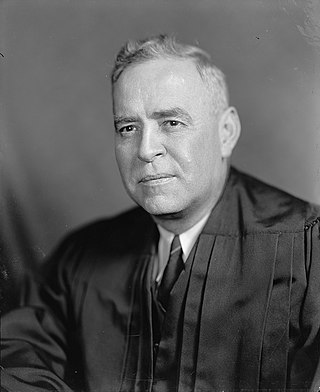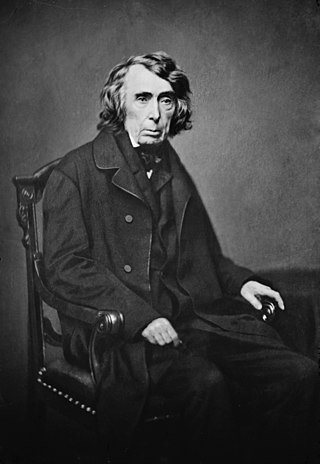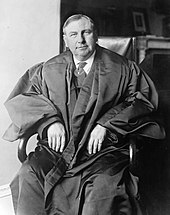
Stanley Forman Reed was an American lawyer and jurist who served as an Associate Justice of the U.S. Supreme Court from 1938 to 1957. He also served as U.S. Solicitor General from 1935 to 1938.

Felix Frankfurter was an Austrian-born American jurist who served as an Associate Justice of the Supreme Court of the United States from 1939 until 1962, during which he was an advocate of judicial restraint.

Owen Josephus Roberts was an associate justice of the United States Supreme Court from 1930 to 1945. He also led two Roberts Commissions, the first of which investigated the attack on Pearl Harbor, and the second of which focused on works of cultural value during World War II.

Wiley Blount Rutledge Jr. was an American jurist who served as an associate justice of the Supreme Court of the United States from 1943 to 1949. The ninth and final justice appointed by President Franklin D. Roosevelt, he is best known for his impassioned defenses of civil liberties. Rutledge favored broad interpretations of the First Amendment, the Due Process Clause, and the Equal Protection Clause, and he argued that the Bill of Rights applied in its totality to the states. He participated in several noteworthy cases involving the intersection of individual freedoms and the government's wartime powers. Rutledge served on the Court until his death at the age of fifty-five. Legal scholars have generally thought highly of the justice, although the brevity of his tenure has minimized his impact on history.

The Warren Court was the period in the history of the Supreme Court of the United States from 1953 to 1969 when Earl Warren served as the chief justice. The Warren Court is often considered the most liberal court in U.S. history.

The Supreme Court of the United States is the only court specifically established by the Constitution of the United States, implemented in 1789; under the Judiciary Act of 1789, the Court was to be composed of six members—though the number of justices has been nine for most of its history, this number is set by Congress, not the Constitution. The court convened for the first time on February 2, 1790.

The Roberts Court is the time since 2005 during which the Supreme Court of the United States has been led by John Roberts as Chief Justice. Roberts succeeded William Rehnquist as Chief Justice after Rehnquist's death.

The Rehnquist Court was the period in the history of the Supreme Court of the United States during which William Rehnquist served as Chief Justice. Rehnquist succeeded Warren Burger as Chief Justice after the latter's retirement, and Rehnquist held this position until his death in 2005, at which point John Roberts was nominated and confirmed as Rehnquist's replacement. The Rehnquist Court is generally considered to be more conservative than the preceding Burger Court, but not as conservative as the succeeding Roberts Court. According to Jeffrey Rosen, Rehnquist combined an amiable nature with great organizational skill, and he "led a Court that put the brakes on some of the excesses of the Earl Warren era while keeping pace with the sentiments of a majority of the country."

The Marshall Court refers to the Supreme Court of the United States from 1801 to 1835, when John Marshall served as the fourth Chief Justice of the United States. Marshall served as Chief Justice until his death, at which point Roger Taney took office. The Marshall Court played a major role in increasing the power of the judicial branch, as well as the power of the national government.

The Burger Court was the period in the history of the Supreme Court of the United States from 1969 to 1986, when Warren E. Burger served as Chief Justice of the United States. Burger succeeded Earl Warren as Chief Justice after the latter's retirement, and served as Chief Justice until his retirement, at which point William Rehnquist was nominated and confirmed as Burger's replacement. The Burger Court is generally considered to be the last liberal court to date. It has been described as a "transitional" court, due to its transition from having the liberal rulings of the Warren Court to the conservative rulings of the Rehnquist Court.

The Taney Court refers to the Supreme Court of the United States from 1836 to 1864, when Roger Taney served as the fifth Chief Justice of the United States. Taney succeeded John Marshall as Chief Justice after Marshall's death in 1835. Taney served as Chief Justice until his death in 1864, at which point Salmon P. Chase took office. Taney had been an important member of Andrew Jackson's administration, an advocate of Jacksonian democracy, and had played a major role in the Bank War, during which Taney wrote a memo questioning the Supreme Court's power of judicial review. However, the Taney Court did not strongly break from the decisions and precedents of the Marshall Court, as it continued to uphold a strong federal government with an independent judiciary. Most of the Taney Court's holdings are overshadowed by the decision in Dred Scott v. Sandford, in which the court ruled that African-Americans could not be citizens. However, the Taney Court's decisions regarding economic issues and separation of powers set important precedents, and the Taney Court has been lauded for its ability to adapt regulatory law to a country undergoing remarkable technological and economic progress.

The Chase Court refers to the Supreme Court of the United States from 1864 to 1873, when Salmon P. Chase served as the sixth Chief Justice of the United States. Chase succeeded Roger Taney as Chief Justice after the latter's death. Appointed by President Abraham Lincoln, Chase served as Chief Justice until his death, at which point Morrison Waite was nominated and confirmed as his successor.

The Waite Court refers to the Supreme Court of the United States from 1874 to 1888, when Morrison Waite served as the seventh Chief Justice of the United States. Waite succeeded Salmon P. Chase as Chief Justice after the latter's death. Waite served as Chief Justice until his death, at which point Melville Fuller was nominated and confirmed as Waite's successor.

The Hughes Court refers to the Supreme Court of the United States from 1930 to 1941, when Charles Evans Hughes served as Chief Justice of the United States. Hughes succeeded William Howard Taft as Chief Justice after the latter's retirement, and Hughes served as Chief Justice until his retirement, at which point Harlan Stone was nominated and confirmed as Hughes's replacement. The Supreme Court moved from its former quarters at the United States Capitol to the newly constructed Supreme Court Building during Hughes's chief-justiceship.

The Vinson Court refers to the Supreme Court of the United States from 1946 to 1953, when Fred M. Vinson served as Chief Justice of the United States. Vinson succeeded Harlan F. Stone as Chief Justice after the latter's death, and Vinson served as Chief Justice until his death, at which point Earl Warren was nominated and confirmed to succeed Vinson.

The Taft Court refers to the Supreme Court of the United States from 1921 to 1930, when William Howard Taft served as Chief Justice of the United States. Taft succeeded Edward Douglass White as Chief Justice after the latter's death, and Taft served as Chief Justice until his resignation, at which point Charles Evans Hughes was nominated and confirmed as Taft's replacement. Taft was also the nation's 27th president (1909–13); he is the only person to serve as both President of the United States and Chief Justice.

The White Court refers to the Supreme Court of the United States from 1910 to 1921, when Edward Douglass White served as Chief Justice of the United States. White, an associate justice since 1894, succeeded Melville Fuller as Chief Justice after the latter's death, and White served as Chief Justice until his death a decade later. He was the first sitting associate justice to be elevated to chief justice in the Court's history. He was succeeded by former president William Howard Taft.

The Fuller Court refers to the Supreme Court of the United States from 1888 to 1910, when Melville Fuller served as the eighth Chief Justice of the United States. Fuller succeeded Morrison R. Waite as Chief Justice after the latter's death, and Fuller served as Chief Justice until his death, at which point Associate Justice Edward Douglass White was nominated and confirmed as Fuller's replacement.
The New Deal often encountered heavy criticism, and had many constitutional challenges.
Schneiderman v. United States, 320 U.S. 118 (1943), was a U.S. Supreme Court case involving denaturalization. By a 5–3 vote, the justices rejected the federal government's attempt to denaturalize William Schneiderman, a self-avowed communist. The Court held that "clear, unequivocal, and convincing" proof was required to revoke citizenship; it determined that there was insufficient evidence that Schneiderman was not "attached to the principles of the Constitution" as required by federal law.






















